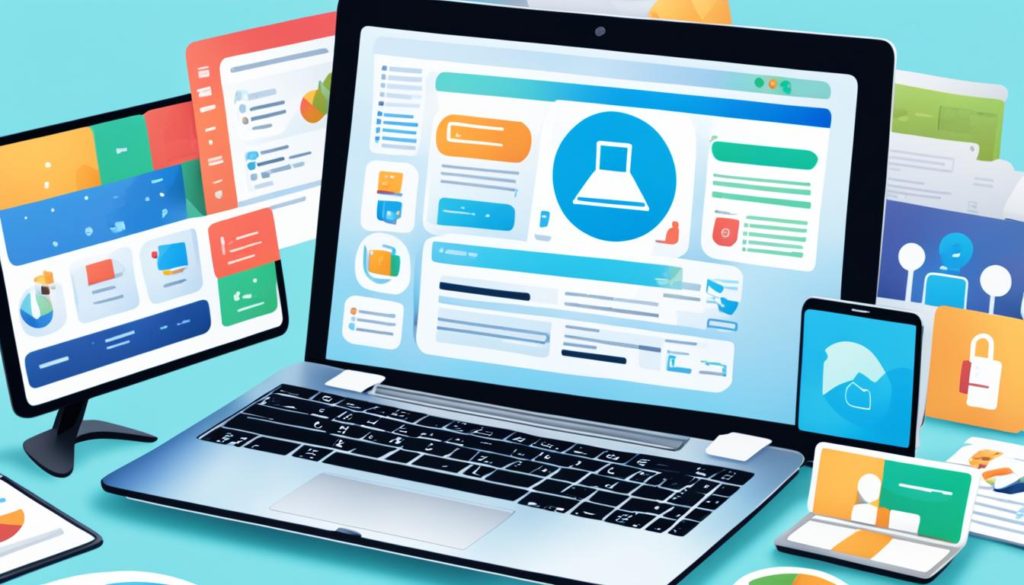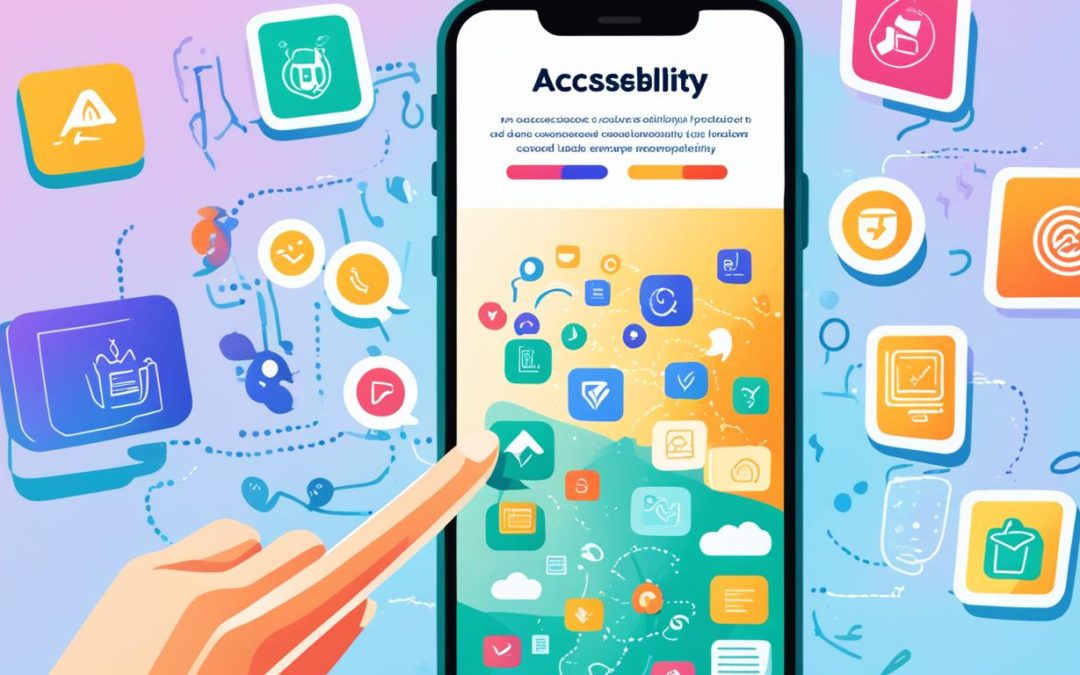Are you looking to enhance your skills in accessible online education? Want to ensure that your mobile apps are inclusive and accessible to everyone? Look no further! The "Introduction to Web Accessibility" online course is here to equip you with the knowledge and expertise you need to make your digital technology accessible.
Whether you're a developer, designer, content author, project manager, or even someone with disabilities themselves, this course is designed for both technical and non-technical learners. It covers a wide range of topics, including coding web applications to meet international standards, designing interfaces for people with disabilities, and advocating for accessibility.
Key Takeaways:
- Enhance your skills in accessible online education
- Make your mobile apps inclusive and accessible
- Designed for both technical and non-technical learners
- Covers coding web applications, designing interfaces, and advocating for accessibility
- Contribute to creating a more inclusive and equitable society
Who the Course is For
The "Introduction to Web Accessibility" course is designed to cater to both technical and non-technical learners. Whether you're a developer, designer, content author, project manager, student, instructor, or professional, this course is suitable for you. It is not limited to individuals with a technical background; even non-technical learners can benefit from the course material.
Accessibility skills are invaluable in today's digital landscape, and this course aims to provide knowledge and resources to a wide range of individuals who create digital content or work in the field of technology. Whether you have a background in programming or not, the course is structured to ensure that learners of all levels can grasp and apply the concepts effectively.
The course also welcomes people with disabilities who are interested in gaining a deeper understanding of web accessibility. By actively participating in the course, they can develop accessibility skills that enable them to contribute meaningfully to the digital world.
Course Content and Topics
The "Introduction to Web Accessibility" course offers a comprehensive curriculum that covers various topics related to web accessibility. Whether you're interested in coding web applications to meet international standards, designing interfaces for people with disabilities, advocating for accessibility, managing accessibility in projects and organizations, or checking web pages for accessibility issues, this course has you covered. You have the flexibility to explore the entire curriculum and delve deeper into specific areas of interest that align with your goals and interests.
Throughout the course, you will gain a deep understanding of the importance of web accessibility and how to implement it effectively. Here's a closer look at some of the key topics covered:
1. Coding Web Applications
In this section, you will learn how to apply coding techniques to ensure that web applications meet international accessibility standards. You'll explore best practices for structuring and organizing code to create an inclusive digital environment for people with disabilities.
2. Designing Interfaces
Designing inclusive interfaces is crucial for providing accessible experiences to all users. This module will teach you how to design user interfaces that are intuitive, user-friendly, and address the specific needs of individuals with disabilities.
3. Advocating for Accessibility
Being an advocate for accessibility involves promoting awareness and implementing inclusive practices. In this section, you'll discover strategies for advocating for accessibility within your projects, organizations, and communities, helping create a more inclusive digital landscape for everyone.
4. Managing Accessibility
Managing accessibility in projects and organizations requires a deep understanding of the relevant principles and processes. This module will equip you with the knowledge and skills to effectively manage accessibility initiatives and integrate accessibility into project workflows.
5. Checking Web Pages
Ensuring the accessibility of web pages is essential for providing an inclusive online experience. In this section, you'll learn how to conduct thorough accessibility checks, identify potential issues, and implement appropriate solutions to make web pages accessible to all users.
The course content is designed to provide you with practical skills and knowledge that you can immediately apply in real-world scenarios. As you progress through the curriculum, you'll have the opportunity to engage with interactive activities, quizzes, and projects that enhance your learning experience.
Duration and Accessibility
The "Introduction to Web Accessibility" course offers the flexibility of self-paced learning, allowing you to complete the course at your own speed. Designed to be easy to follow, the course is structured to take approximately 16-20 hours to finish. Whether you have a busy schedule or prefer a more leisurely pace, this self-paced format ensures that you can learn at a speed that suits you best.
This is a free course, which means you can access the content without any cost. It's an excellent opportunity to acquire essential accessibility skills without any financial burden. Additionally, the course will be available on the edX platform until at least August 2024, giving you ample time to start and complete the course at your convenience. So, even if you're unable to enroll right away, you can rest assured knowing that the course will still be accessible to you in the future.

Whether you're a busy professional, a student juggling multiple commitments, or someone with a busy personal life, self-paced learning allows you to fit your studies around your schedule. With 16-20 hours of content, this course can be completed in manageable chunks over several days or even weeks. This flexibility ensures that you can learn at your own pace without feeling overwhelmed.
Moreover, the accessibility of the course extends beyond its flexible timeline. The course has been carefully designed to cater to learners of various backgrounds and abilities. Whether you have prior technical knowledge or are approaching the subject as a non-technical learner, the course is tailored to accommodate individuals with different learning styles and levels of expertise.
So, whether you're an aspiring developer looking to enhance your web development skills or a content author seeking to make your digital content inclusive, the "Introduction to Web Accessibility" course provides an accessible and comprehensive learning experience. Take advantage of the self-paced format, the estimated 16-20 hours of engaging content, and the freedom to access it for free until August 2024.
Instructor and Course Providers
The "Introduction to Web Accessibility" course is developed and provided by two renowned organizations in the field of technology and education: the World Wide Web Consortium (W3C) Web Accessibility Initiative (WAI) and the United Nations Educational, Scientific and Cultural Organization (UNESCO) Institute for Information Technologies in Education (IITE).
This course is based on open curricula from the W3C WAI Education and Outreach Working Group (EOWG), ensuring that learners receive up-to-date and comprehensive content on web accessibility.
Throughout the course, participants have the unique opportunity to learn from a diverse group of international expert trainers. These trainers come from prominent organizations in the field, including:
- Deque
- Infoaxia
- Intopia
- Knowbility
- The Paciello Group (TPG)
- Web Key IT
- W3C WAI
With the guidance of these expert trainers, learners can benefit from their extensive knowledge and practical experience in web accessibility.
Skills Gained
By completing the course, you will gain a variety of valuable skills related to web accessibility. These skills will enhance your expertise in web development, user experience design, front-end web development, and full-stack web development. The course covers essential aspects of accessibility that can be utilized in various professional settings.
Throughout the course, you will have the opportunity to develop a deep understanding of accessibility principles and their impact on web development. You will acquire the necessary skills to create websites and applications that are inclusive and accessible to all users, including those with disabilities.
With a focus on user experience design, you will learn how to design interfaces that are intuitive, user-friendly, and considerate of diverse user needs. This knowledge will enable you to create digital experiences that prioritize accessibility and provide a seamless user journey for individuals with disabilities.
"Accessibility is not just about compliance; it's about creating digital experiences that are inclusive and empower everyone." - Web Accessibility Expert
The course also delves into front-end web development, providing you with the skills to implement accessibility features and optimize website performance. You will learn techniques to enhance website navigation, improve readability and readability with assistive technologies, and ensure compatibility across different platforms and devices.
Additionally, the course covers the fundamentals of full-stack web development, equipping you with the knowledge of back-end technologies and database management. This comprehensive understanding will enable you to develop accessible and dynamic web applications that meet the needs of all users.
By gaining proficiency in accessibility skills, you will be well-equipped to create digital solutions that prioritize inclusivity and provide equal access to information and services for individuals with disabilities.
Other Online Courses with Web Accessibility Focus
Apart from the "Introduction to Web Accessibility" course, there are several other online courses available that focus on web accessibility. These courses provide learners with additional opportunities to expand their knowledge in the field and gain valuable skills. Here are some popular options:
"Introduction to Accessibility and Inclusive Design" from the University of Illinois at Urbana-Champaign
This course offers a comprehensive introduction to accessibility and inclusive design principles. It covers topics such as enhancing the user experience for people with disabilities, creating accessible web content, and implementing accessibility standards. Whether you're a developer, designer, or content creator, this course can help you improve your skills in creating inclusive digital experiences.
"Web Design for Everybody" from the University of Michigan
Designed for beginners, this course provides a solid foundation in web design principles and techniques. It emphasizes the importance of web accessibility and teaches learners how to create accessible websites following best practices. By the end of the course, you'll have the skills needed to design visually appealing and user-friendly websites that are accessible to all users, including those with disabilities.
"Foundations of User Experience (UX) Design" offered by Google
This course covers various aspects of user experience (UX) design, including accessibility. It explores how to design digital products and interfaces that are usable and inclusive. By understanding the diverse needs of users, including those with disabilities, you can create more accessible and enjoyable user experiences. Whether you're new to UX design or looking to enhance your skills, this course offers valuable insights and practical techniques.

These courses, along with the "Introduction to Web Accessibility," provide learners with a range of options to delve deeper into the world of web accessibility. Whether you're interested in accessibility and inclusive design, web design, or user experience, these courses offer the knowledge and skills necessary to create digital experiences that are accessible to everyone.
Importance of Accessibility
Accessibility is not only a legal requirement but also a moral and ethical imperative. It ensures that individuals with disabilities can access digital content, physical spaces, products, and services. The primary goal of accessibility is to create an inclusive society where everyone, regardless of their abilities, can participate fully in the digital world and engage in physical environments without discrimination. It is essential for creating a more equitable and inclusive society for all.
By prioritizing accessibility, we are taking meaningful steps towards building a society that values inclusivity and recognizes the diversity of human experiences. When digital platforms and physical spaces are accessible, individuals with disabilities can navigate them with ease, accessing information, and engaging in activities that were previously inaccessible. This not only empowers individuals but also contributes to the overall progress and development of our society.
From an educational perspective, accessibility plays a crucial role in providing equal opportunities for learning. Accessible educational materials and technologies enable students with disabilities to access the same information and resources as their peers, fostering an environment of inclusivity and promoting academic success for all students.
The Benefits of Accessibility
When we embrace accessibility, we unlock a multitude of benefits for individuals, organizations, and society as a whole. Some of these benefits include:
- Increased participation and engagement for individuals with disabilities
- Enhanced user experience for all users
- Improved search engine optimization and online visibility
- Compliance with legal requirements and avoidance of penalties
- Expanded customer base and market reach
- Positive brand image and reputation
- Promotion of social responsibility and ethical business practices
By recognizing the importance of accessibility, we are taking a significant step towards creating a more inclusive and equitable society. It is our collective responsibility to ensure that everyone, regardless of their abilities, has equal access to information, services, and opportunities. Together, we can build a world where accessibility is a cornerstone of progress and success.
Conclusion
Online courses play a pivotal role in providing accessible education to individuals, especially in the realm of mobile app accessibility. These courses offer the flexibility for learners to access educational content anytime and anywhere, breaking down barriers and ensuring inclusivity.
By enrolling in online courses that focus on mobile app accessibility, individuals gain the skills needed to create digital content that is accessible to all. Through these courses, learners learn techniques to improve the user experience for people with disabilities, fostering a more inclusive and equitable digital landscape.
Education is a powerful tool, and technology in education has the potential to transform lives. With accessible education and online courses, individuals can contribute to creating a more inclusive society, embracing the benefits of technology while ensuring that no one is left behind. The future of education lies in the hands of those who are willing to learn, adapt, and advocate for accessible education for all.
FAQ
Who is the "Introduction to Web Accessibility" online course designed for?
The course is designed for both technical and non-technical learners, including developers, designers, content authors, project managers, students, instructors, professionals, and even people with disabilities themselves. It aims to provide accessibility knowledge for a wide range of individuals who create digital content or work in the field of technology.
What topics does the course cover?
The course covers a wide range of topics, including coding web applications to meet international standards, designing interfaces for people with disabilities, advocating for accessibility, managing accessibility in projects and organizations, and checking web pages for accessibility issues. It encourages learners to explore the entire curriculum while allowing them to delve deeper into specific areas of interest.
How long does it take to complete the course?
The course is self-paced and takes approximately 16-20 hours to complete for most people. Participants can progress at their own speed and complete the course as quickly or as slowly as they prefer.
Is the course free?
Yes, the course is free to access. Learners can start auditing the course immediately without any cost. There is an optional certificate available for USD if learners choose to obtain a Verified Certificate.
Who provides the course?
The course is provided by the World Wide Web Consortium (W3C) Web Accessibility Initiative (WAI) and the United Nations Educational, Scientific and Cultural Organization (UNESCO) Institute for Information Technologies in Education (IITE). It features international expert trainers from prominent organizations such as Deque, Infoaxia, Intopia, Knowbility, The Paciello Group (TPG), Web Key IT, and W3C WAI.
What skills can learners gain from completing the course?
By completing the course, learners can gain a variety of skills related to web accessibility, including knowledge in web development, user experience design, front-end web development, and full-stack web development. These skills can be applied in a variety of professional settings.
Are there other online courses available with a focus on web accessibility?
Yes, apart from the "Introduction to Web Accessibility" course, there are several other online courses available. Some popular options include "Introduction to Accessibility and Inclusive Design" from the University of Illinois at Urbana-Champaign, "Web Design for Everybody" from the University of Michigan, and "Foundations of User Experience (UX) Design" offered by Google. These courses cover various aspects of accessibility and provide learners with additional opportunities to expand their knowledge in the field.
Why is accessibility important?
Accessibility is not only a legal requirement but also a moral and ethical imperative. It ensures that individuals with disabilities can access digital content, physical spaces, products, and services. The primary goal of accessibility is to create an inclusive society where everyone, regardless of their abilities, can participate fully in the digital world and engage in physical environments without discrimination. It is essential for creating a more equitable and inclusive society for all.
Why are online courses that offer mobile app accessibility valuable?
Online courses that offer mobile app accessibility provide an opportunity for individuals to access education anytime and anywhere. These courses are designed to equip learners with the necessary skills to create accessible digital content and improve the user experience for people with disabilities. By completing these courses, individuals can contribute to creating a more inclusive and equitable society.









